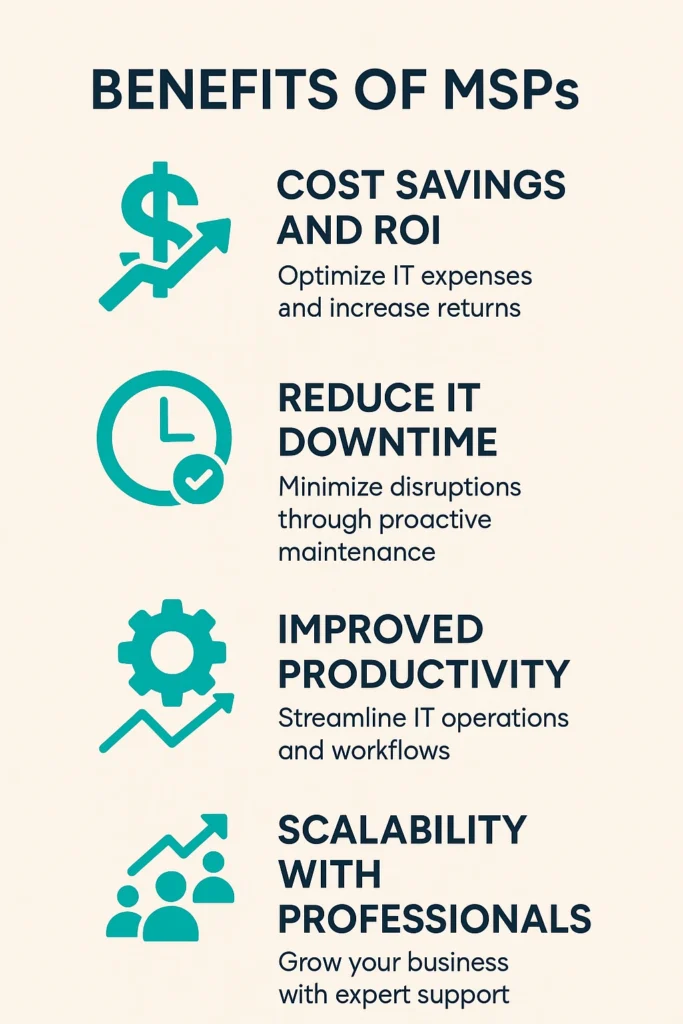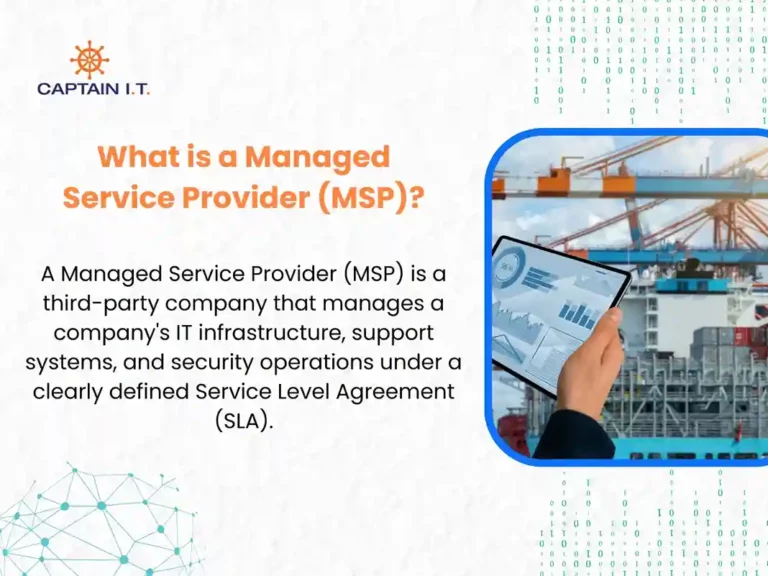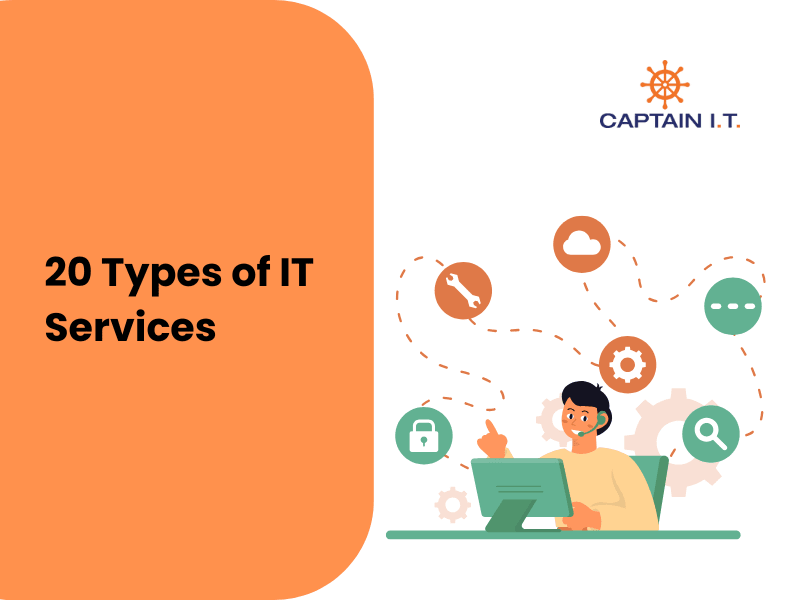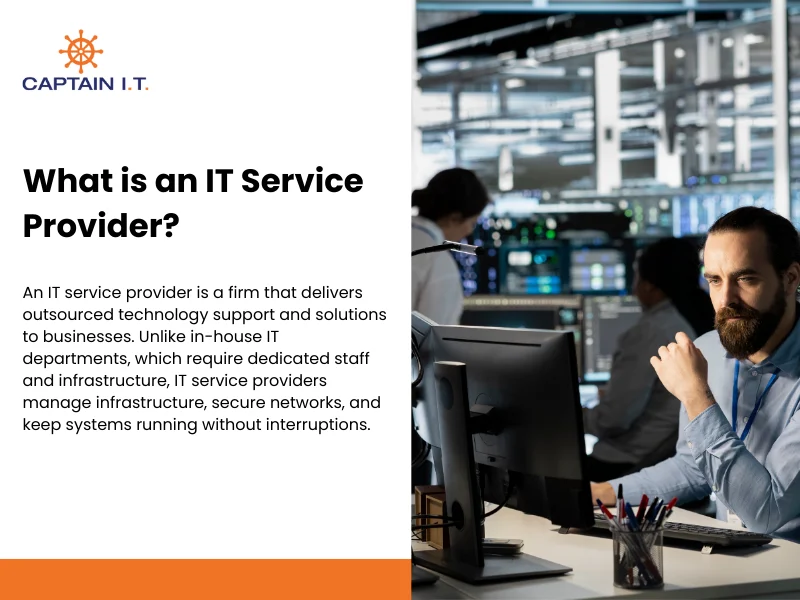A Managed Service Provider (MSP) is a third-party company that remotely manages a business’s IT infrastructure and operations. MSPs offer continuous monitoring, maintenance, and support to ensure systems run smoothly, securely, and efficiently. By taking on these responsibilities, MSPs help businesses avoid downtime and reduce IT-related risks.
The importance of MSPs lies in their ability to provide expert IT management without the need for businesses to build and maintain an internal team. This allows companies to focus on their core activities while benefiting from advanced technology, proactive problem-solving, and cost-effective solutions. MSPs also enable faster response times and help businesses stay compliant with evolving security standards.
MSPs offer a wide range of IT services, including network management, cybersecurity, cloud computing, help desk support, and data backup. Their comprehensive approach ensures that businesses have reliable, scalable IT resources tailored to their unique needs, supporting growth and operational continuity.
Why Do Businesses Use MSPs?
Businesses use MSPs to delegate complex IT functions to specialized providers, allowing internal teams to focus on core operations. MSPs improve operational efficiency, reduce downtime, and ensure continuous IT system performance through proactive management and expert support.
- Help Desk & Remote Support
Businesses rely on MSPs for quick and accessible technical assistance through help desks and remote support. This service enables immediate troubleshooting without the need for onsite visits, reducing resolution times and minimizing disruptions to daily workflows. - Patch Management & Monitoring
MSPs manage software updates and security patches to keep systems secure and up to date. Constant monitoring detects vulnerabilities early, allowing businesses to prevent cyber threats and maintain compliance with industry standards. - Cloud Migration & Email Hosting
Outsourcing cloud migration and email hosting to MSPs simplifies the transition to scalable cloud environments. MSPs handle data transfer and setup while ensuring reliable email services, enhancing collaboration, and reducing infrastructure burdens on businesses.
How Do MSPs Work?
Managed Service Providers (MSPs) work by continuously managing and supporting a company’s IT environment to ensure optimal performance, security, and uptime. They apply a proactive approach through constant monitoring, maintenance, and rapid issue resolution, all governed by a clear Service-Level Agreement (SLA) that defines the scope and expectations of service.
The step-by-step working procedure of MSP is detailed below:
- IT Assessment and Onboarding:
The process begins with a thorough evaluation of the organization’s current IT setup. MSPs identify weaknesses, outdated systems, and potential risks. Based on this assessment, they develop a customized IT strategy aligned with the company’s business goals and technology requirements. - Service Level Agreement (SLA) Setup:
An SLA is crafted to clearly outline the services provided, response times, and performance benchmarks. This agreement also specifies pricing models and details responsibilities, ensuring transparency and accountability between the MSP and the client. - Onboarding and Integration:
MSPs implement specialized software and tools like remote monitoring and management (RMM) platforms, ticketing systems, and security solutions. These integrations allow MSPs to track network health, automate routine tasks, and secure the IT infrastructure without interrupting daily business operations. - Proactive Monitoring and Maintenance:
Through ongoing surveillance of systems and networks, MSPs identify and address issues before they escalate. Regular patch management, software updates, and hardware upkeep help maintain system stability and prevent downtime, supporting business continuity. - Incident Response and Support:
If technical problems arise, MSPs provide swift and effective support. Using diagnostic tools and remote access capabilities, they troubleshoot and resolve issues promptly, minimizing operational disruptions. For critical situations, on-site assistance may be deployed to ensure full recovery and security.
Types of MSP Models
The different types of MSP models vary based on the scope of management and the specific services they provide, allowing businesses to choose a model that best fits their IT needs and strategic goals.
Based on Scope
MSPs based on the scope are categorized into two types. The range of services offered by these MSPs differs from comprehensive IT solutions to dedicated needs and a collaborative approach with the in-house team to enhance support.
- Fully Managed MSPs: These providers assume complete responsibility for all IT functions, delivering end-to-end management of infrastructure, security, and user support. This model suits businesses looking for a cost-efficient, all-inclusive IT solution that requires minimal internal supervision.
- Co-Managed MSPs: This model fosters collaboration between the MSP and the in-house IT team. The MSP offers specialized expertise and advanced tools, while the internal team retains control over core operations. It benefits organizations that want to maintain IT oversight but need external support for complex or resource-intensive tasks.
Based on Service
Service-based MSP models concentrate on specialized IT domains, delivering tailored solutions that address specific business needs. Two primary types include:
- Cloud MSP: This model centers on managing cloud infrastructures by handling tasks such as cloud migration, ongoing maintenance, and performance optimization to ensure scalable and efficient cloud operations.
- MSSP (Managed Security Service Provider): MSSPs specialize in cybersecurity services, offering continuous threat detection, rapid incident response, and compliance enforcement to safeguard critical business data and systems.
MSP Vs Internal IT Team
The main difference between Managed Service Providers (MSPs) and internal IT teams lies in service delivery and resource scalability. While MSPs offer outsourced, flexible, and cost-effective support with access to specialized expertise, internal IT provides full-time, on-site control that may lack the broad capabilities and round-the-clock monitoring that external providers deliver.
| Feature/Aspect | Managed Service Provider (MSP) | Internal IT Team |
| Expertise | Offers a diverse team of specialists across multiple IT disciplines. | Limited to the knowledge and skills of in-house staff. |
| Cost Structure | Predictable monthly fees with scalable options to control expenses. | Higher fixed costs due to salaries, benefits, and training. |
| Support Availability | Provides 24/7 monitoring and support for rapid issue resolution. | Usually available during business hours, causing potential delays. |
| Scalability | Easily adjusts to business growth and changing IT demands. | Scaling requires hiring and training, which can be slow and costly. |
| Focus on Core Business | Frees internal teams to prioritize strategic projects over daily tasks. | Often tied up with routine maintenance and user support. |
| Security and Compliance | Maintains up-to-date cybersecurity and compliance expertise. | May lack the resources to address evolving security threats fully. |
| Response Time | Quick incident response enabled by dedicated tools and resources. | Response times may lag due to limited personnel and workload. |
What are the Benefits of MSPs?
The benefits of partnering with an MSP include significant cost savings and strong ROI, reduced IT downtime, improved productivity, and scalable support delivered by IT professionals. These advantages enable businesses to operate more efficiently while focusing on growth.

- Saves Cost:
Leveraging an MSP’s subscription-based pricing model allows businesses to predict and control IT costs more effectively while avoiding unexpected expenses. Outsourcing IT functions also removes the financial burden of recruiting, training, and retaining in-house staff. According to the Managed Services Market 2024 report, adopting managed IT services can reduce operational costs by up to 45% and boost operational efficiency by as much as 65%. - Reduce IT Downtime:
MSPs minimize downtime through continuous system monitoring and early detection of potential issues. Their 24/7 support and fast response times ensure technical problems are resolved quickly, preventing disruptions to daily business activities. Market.us Scoop reports that proactive MSP support can achieve up to 99.99% network uptime, saving companies significant productive hours. - Improved Productivity:
By managing routine IT tasks and troubleshooting, MSPs free internal teams to focus on core business strategies and innovation. This reduction in IT-related distractions allows employees to dedicate more time to their primary roles, increasing overall efficiency. Streamlined workflows and minimized downtime accelerate project delivery and support faster, enabling data-driven decision-making. As a result, organizations can respond more quickly to market changes and maintain a competitive edge. - Scalability with Professionals:
Flexible IT solutions from MSPs enable businesses to scale their technology resources effortlessly. Whether expanding operations or adapting to seasonal demands, MSPs ensure resources are adjusted promptly without the typical delays or costs of recruiting and training new staff. Their cloud-based platforms and strategic planning capabilities allow seamless integration of additional services and capacity, keeping your IT environment agile and aligned with evolving business goals.
Challenges Of MSP
While MSPs offer valuable IT support, they face several challenges that can impact service delivery and client satisfaction. Understanding these challenges helps businesses and providers work together more effectively.
- Assessing True Capabilities:
Evaluating an MSP’s real technical skills and industry expertise can be difficult. Marketing materials may overstate abilities, making it hard to determine if the provider can meet your specific IT needs. Without clear proof of competency, businesses risk choosing an ill-fitting partner.
To mitigate this risk, businesses should ask for detailed case studies, client references, and relevant certifications to verify the provider’s competencies before making a decision. - Aligning Service Offerings with Business Needs:
Companies often struggle to find an MSP whose service offerings align precisely with their operational requirements and budget constraints. Choosing too broad or generic a package can lead to overspending or inadequate support.
Engaging in a thorough needs assessment and requesting customizable service plans helps ensure that the chosen MSP can scale and adapt its offerings to fit your business precisely. - Evaluating Security and Compliance Standards:
Ensuring an MSP adheres to the necessary cybersecurity protocols and compliance standards is complex. Overlooking this can expose your business to data breaches or regulatory penalties after hiring.
Businesses should request proof of compliance certifications, such as GDPR or HIPAA, and inquire about the MSP’s security policies and incident response capabilities to guarantee alignment with required standards.
MSP Pricing Models
The pricing structure of Managed Service Providers (MSPs) includes tiered, per-user, per-device, monitoring-only, hourly or project-based, and custom pricing. Each pricing structure varies based on the type of service provided, the scale of the business, and the preferred model.
Tiered Pricing
Under the tiered pricing model, businesses can choose from multiple levels of services. It ranges from basic packages with essential features like remote support and network monitoring, to premium solutions with enhanced capabilities like after-hor support, on-site assistance, and vCIO. This model allows organizations to choose the package that is best for their needs. Predictable pricing, flexibility, and scalability are some benefits of tiered pricing.
Here is a general price breakdown of the tiered pricing model.
- Basic/Bronze: $70 – $90 per month
- Standard/Silver: $80 – $100 per month
- Premium/Gold: $100 – $150 per month
Per-User Pricing
MSPs offer a per-user pricing model based on the number of individuals requiring support. Price is constructed on an end-user basis with everyone getting standardized support for a flat monthly fee. This is the most common MSP pricing model favored in remote and hybrid environments. The per-user pricing structure is mostly used in the SaaS industry.
The average per-user pricing for MSP is $125 – $250 per user per month.
Per-Device Pricing
In the per-device pricing, MSPs determine costs based on the number of managed devices, such as laptops, desktops, and servers. The price varied based on the device. For example, the third-party vendor can set $50 per laptop, $30 per printer, and $350 per server. The monthly cost according to per-device pricing for these devices will be $430 ($50+$30+350). As the number of devices increases, the overall price will also increase.
Below is the average per-device pricing prevalent in the IT sector.
- $200 – $400 per month per server
- $50 – $100 per month per individual device (mobile, laptop, desktop)
- $25 – $85 per month per networking equipment
Monitoring-only pricing
In monitoring-only pricing, MSPs charge based solely on the monitoring services provided for client devices and systems, without including additional management or support tasks. This pricing model focuses on real-time system surveillance, alerting, and reporting. For example, monitoring one laptop might cost $40 and one server $300, totaling $340 monthly. As the number of monitored devices grows, the total monthly fee increases accordingly.
Typical monitoring-only pricing ranges include:
- $75 – $350 per server per month
- $10 – $30+ per individual device per month
- $20 – $100+ per networking equipment per month
Hourly or Project-Based Pricing
External providers charge by the hour or per project under the hourly or project-based pricing model. Major influencing factors are the time and resources required to complete specific IT tasks. Under this model, short-term projects or one-time support needs are carried out, where expectations are set. There is less chance of dispute, and since the pricing is fixed, cost estimation becomes easy.
Custom Pricing
Under custom pricing or À la Carte model, the price varies based on the business’s unique requirements. Organizations can select the IT services they require and compile them in a bundle, and MSPs will only charge for the selected services. Ideal for businesses with specialized needs, À la Carte pricing offers customizable, cost-effective solutions that can be easily aligned with strategic goals.
Things to Consider Before Hiring an MSP
Before hiring an MSP, businesses should evaluate several critical factors to ensure the provider aligns with their IT needs and goals. Key considerations include the MSP’s technical expertise, service offerings, scalability, and quality of customer support. It is important to verify their experience in your industry and confirm they provide clear Service-Level Agreements (SLAs) outlining response times and responsibilities.
With security being a major concern, the MSP must demonstrate strong cybersecurity practices and compliance with relevant regulations. Additionally, the ability to scale services as your business grows and adapts to new technologies is essential for long-term success.
Connecting these factors to local expertise, Captain IT offers scalable IT services to businesses across Southern California, including Los Angeles, Riverside, Orange County, Irvine, and San Diego. Our strong track record and customer-first approach make us a reliable partner for comprehensive IT management.



